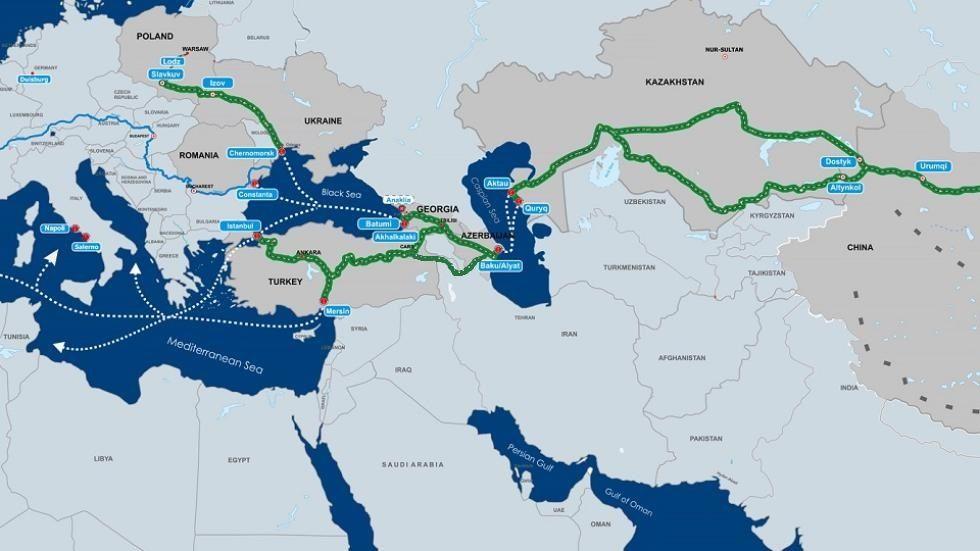Zangezur Corridor Connects East-West, North-South Routes With 15 Million-Ton Freight Boost
In recent years, Azerbaijan has rapidly repositioned itself as a vital player in Eurasian logistics, leveraging its geographic location at the crossroads of East and West, North and South. Through strategic investments in multimodal infrastructure, Azerbaijan has steadily transformed from a regional player into a key transit hub linking Asia with Europe. At the heart of this transformation lies the country's active participation in flagship transit routes such as the Middle Corridor (Trans-Caspian International Transport Route) and the North–South Transport Corridor, as well as ambitious national projects like the Zangezur Corridor (TRIPP Corridor).
As global trade flows evolve in response to shifting geopolitical realities, climate goals, and the search for more resilient supply chains, Azerbaijan's multimodal positioning is gaining unprecedented relevance. The country is not only capitalizing on its existing logistics infrastructure but is also investing in new corridors that serve as alternatives to traditional East-West and North-South routes - most notably through the development of the Zangezur Corridor.
According to Bakhtiyar Hajiyev, Head of the Public Relations Department of Azerbaijan Railways CJSC, the growing trade volume through the Middle Corridor highlights its rising strategic importance. Speaking to journalists, Hajiyev pointed to the role of international financial institutions in validating the corridor's growth prospects.
“According to forecasts from the World Bank, the EBRD, and the OECD, freight along the Middle Corridor is expected to reach 11 million tons by 2030, with container traffic potentially hitting 865,000 TEU by 2040. In this context, the Zangezur Corridor, a key extension of the Middle Corridor, is especially significant,” said Hajiyev.
With an estimated annual freight potential of 15 million tons, the Zangezur Corridor not only enhances capacity but adds crucial redundancy and resilience to the existing Eurasian transport architecture. Hajiyev emphasized that Zangezur is more than just a complementary link - it plays a dual role, reinforcing both the East-West Middle Corridor and the North-South International North-South Transport Corridor (INSTC).
“This underscores the corridor's added value... providing an alternative to existing routes and enabling diversified cargo movement in multiple directions,” Hajiyev noted.“It further strengthens the region's transit potential and establishes Azerbaijan as a major logistics hub.”
This strategic redundancy is crucial in an era of heightened geopolitical instability. With traditional trade corridors facing disruptions - from sanctions, conflicts, and infrastructure chokepoints - diversified, neutral, and efficient routes like Zangezur are becoming invaluable to global trade actors.
A recent interview by President Ilham Aliyev with Saudi Arabia's Al Arabiya TV shed further light on the broader ambition behind the Zangezur Corridor. The project was framed not merely as a domestic infrastructure initiative but as a transformative regional integration platform.
President Aliyev outlined how Zangezur - by directly linking mainland Azerbaijan with Nakhchivan - eliminates the need for detours through Iran or via Georgia and Türkiye. But more critically, the corridor is envisioned as a missing link in the greater Eurasian connectivity map, offering a direct, secure, and high-capacity route for cargo moving between China, Central Asia, the Caucasus, and Europe.
This framing positions Zangezur not only as an economic corridor but also as a tool for regional diplomacy, trade liberalization, and geopolitical balancing.
A corridor within corridors: Strategic synergy with Middle and North–South routes
The Middle Corridor, operational since 2014, already connects China, Kazakhstan, Azerbaijan, Georgia, and Türkiye, offering a vital east-west artery that circumvents Russian and Iranian territories. While it has traditionally been viewed as an alternative to the northern (Russia-based) and southern (Iran-based) corridors, Zangezur's integration into this network further deepens its strategic depth.
The corridor also aligns seamlessly with the North–South Transport Corridor, which connects India, Iran, Russia, and Northern Europe via Azerbaijan. As Hajiyev noted, Zangezur opens new paths for Indian and Iranian cargo to move northward through Azerbaijan, with potential routes passing through Nakhchivan into Türkiye and onwards to Europe.
In effect, Zangezur acts as a pivot point, a physical and symbolic node linking two of the most important transit routes across Eurasia. This multicorridor convergence elevates Azerbaijan's role from a transit participant to a critical connector and gatekeeper of Eurasian trade.
The Zangezur Corridor exemplifies how infrastructure can be wielded as strategic policy. For Azerbaijan, it is not just about shorter travel distances or increased freight volume, it is about deepening its geopolitical relevance, attracting international investment, and embedding itself into the global supply chain architecture.
As the world increasingly turns to diversified, secure, and sustainable logistics options, Azerbaijan's role as a multi-corridor hub will only grow. Whether in facilitating East-West or North-South trade, or in fostering regional cooperation, the Zangezur Corridor stands as a testament to Azerbaijan's evolving identity - from energy exporter to transit enabler, from periphery to pivot.
Legal Disclaimer:
MENAFN provides the
information “as is” without warranty of any kind. We do not accept
any responsibility or liability for the accuracy, content, images,
videos, licenses, completeness, legality, or reliability of the information
contained in this article. If you have any complaints or copyright
issues related to this article, kindly contact the provider above.
Market Research

- Gas Engine Market Analysis: Strong Growth Projected At 3.9% CAGR Through 2033
- Daytrading Publishes New Study On The Dangers Of AI Tools Used By Traders
- Excellion Finance Launches MAX Yield: A Multi-Chain, Actively Managed Defi Strategy
- United States Lubricants Market Growth Opportunities & Share Dynamics 20252033
- ROVR Releases Open Dataset To Power The Future Of Spatial AI, Robotics, And Autonomous Systems
- Blackrock Becomes The Second-Largest Shareholder Of Freedom Holding Corp.



















Comments
No comment